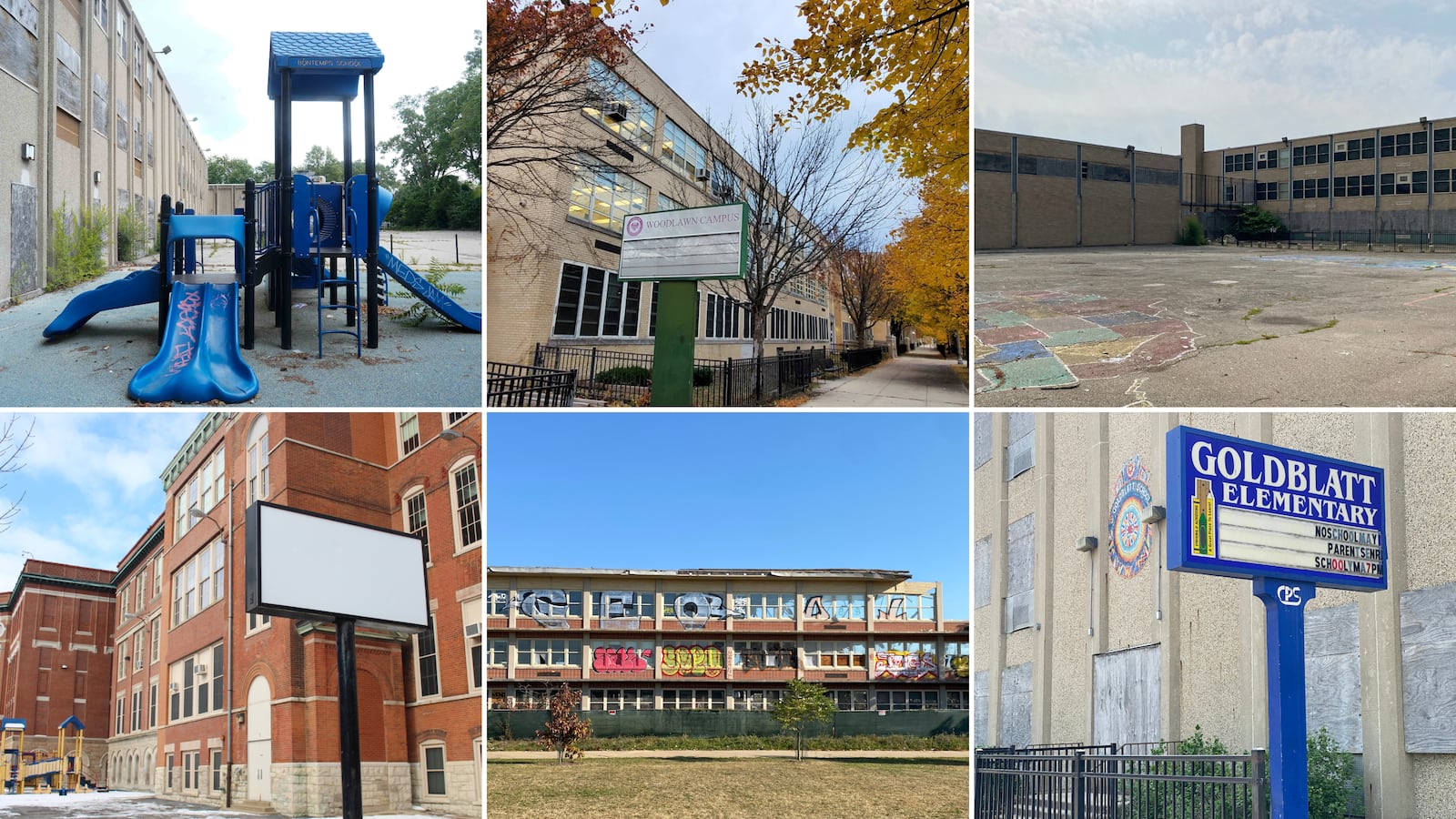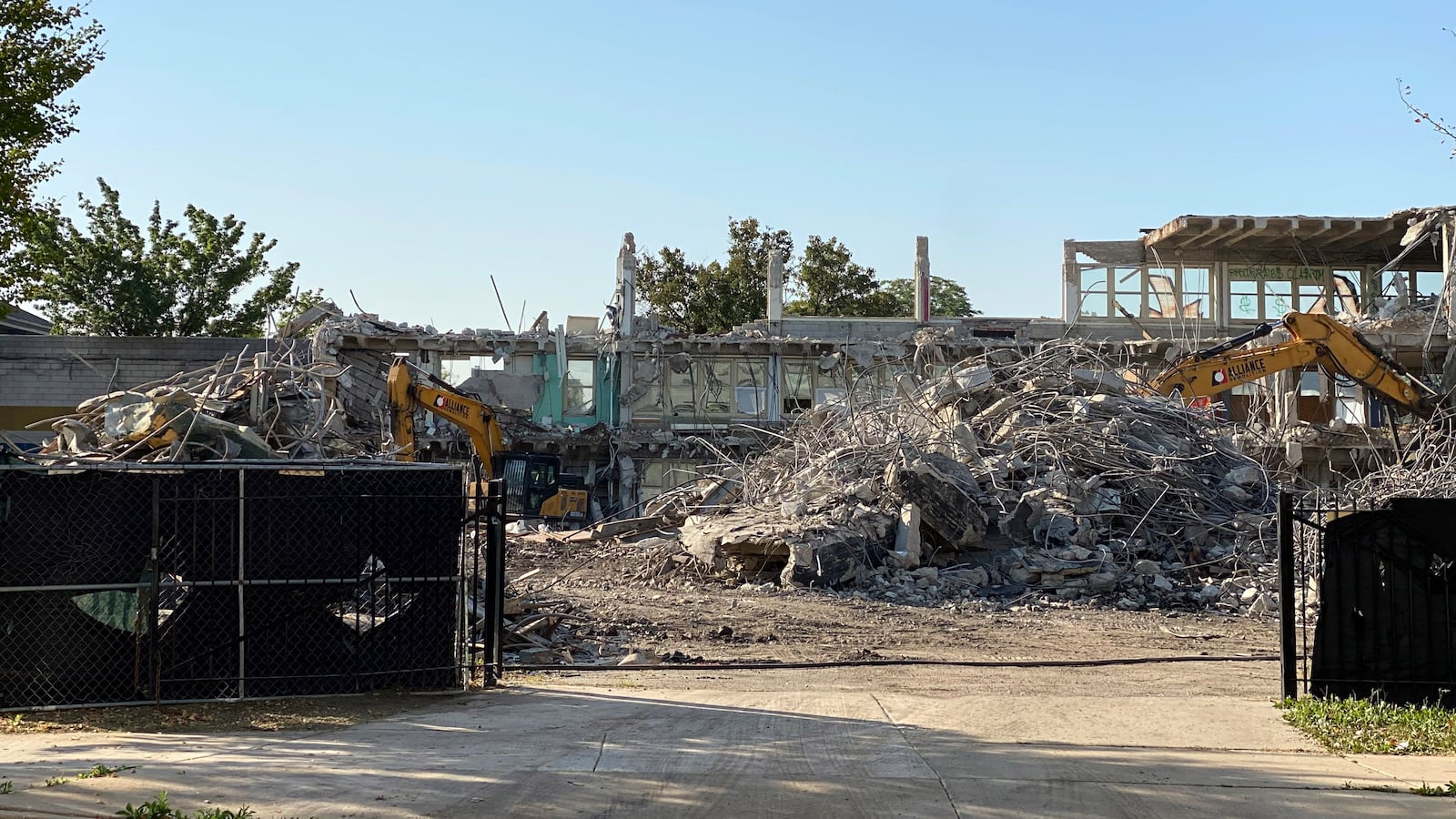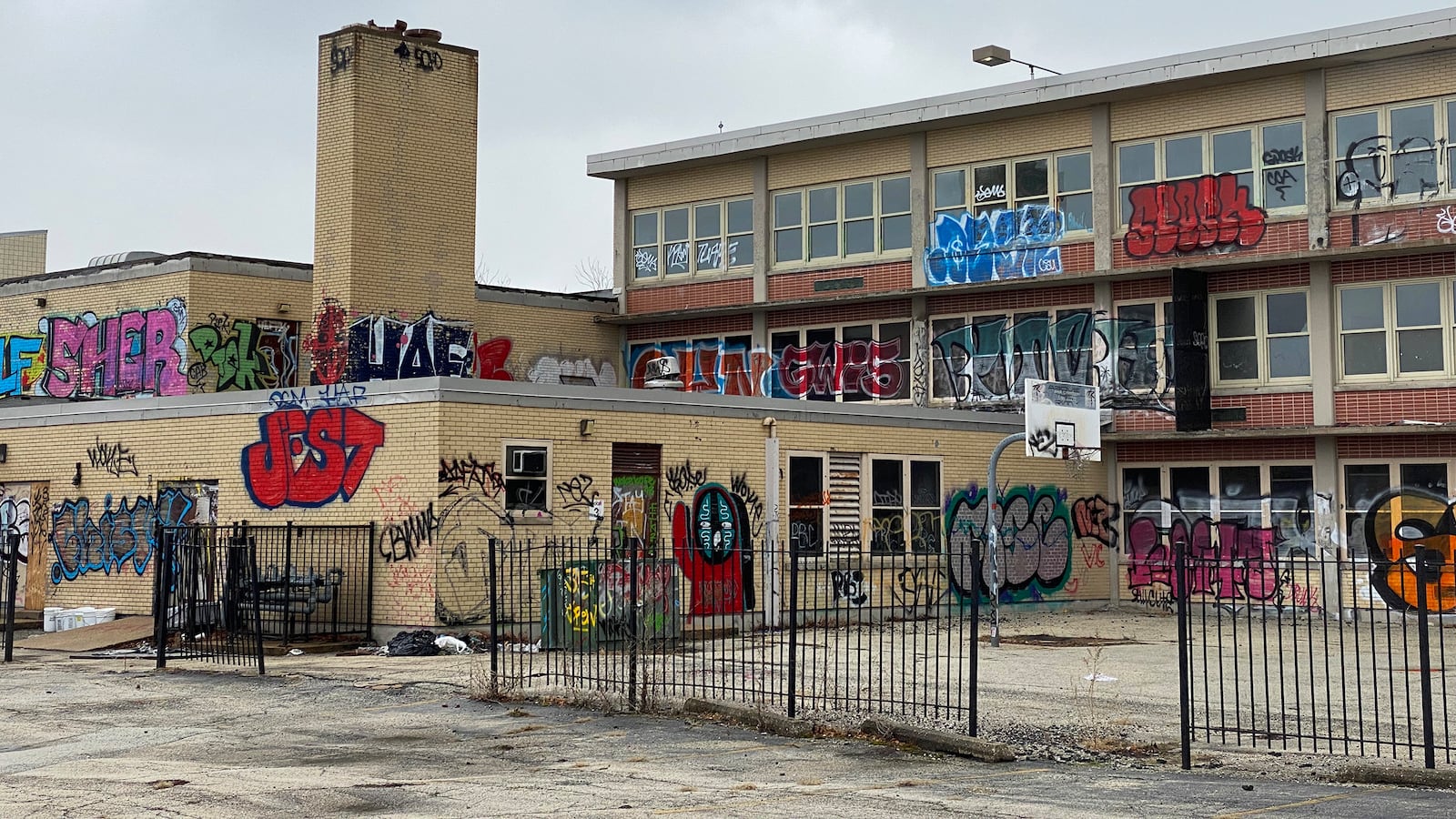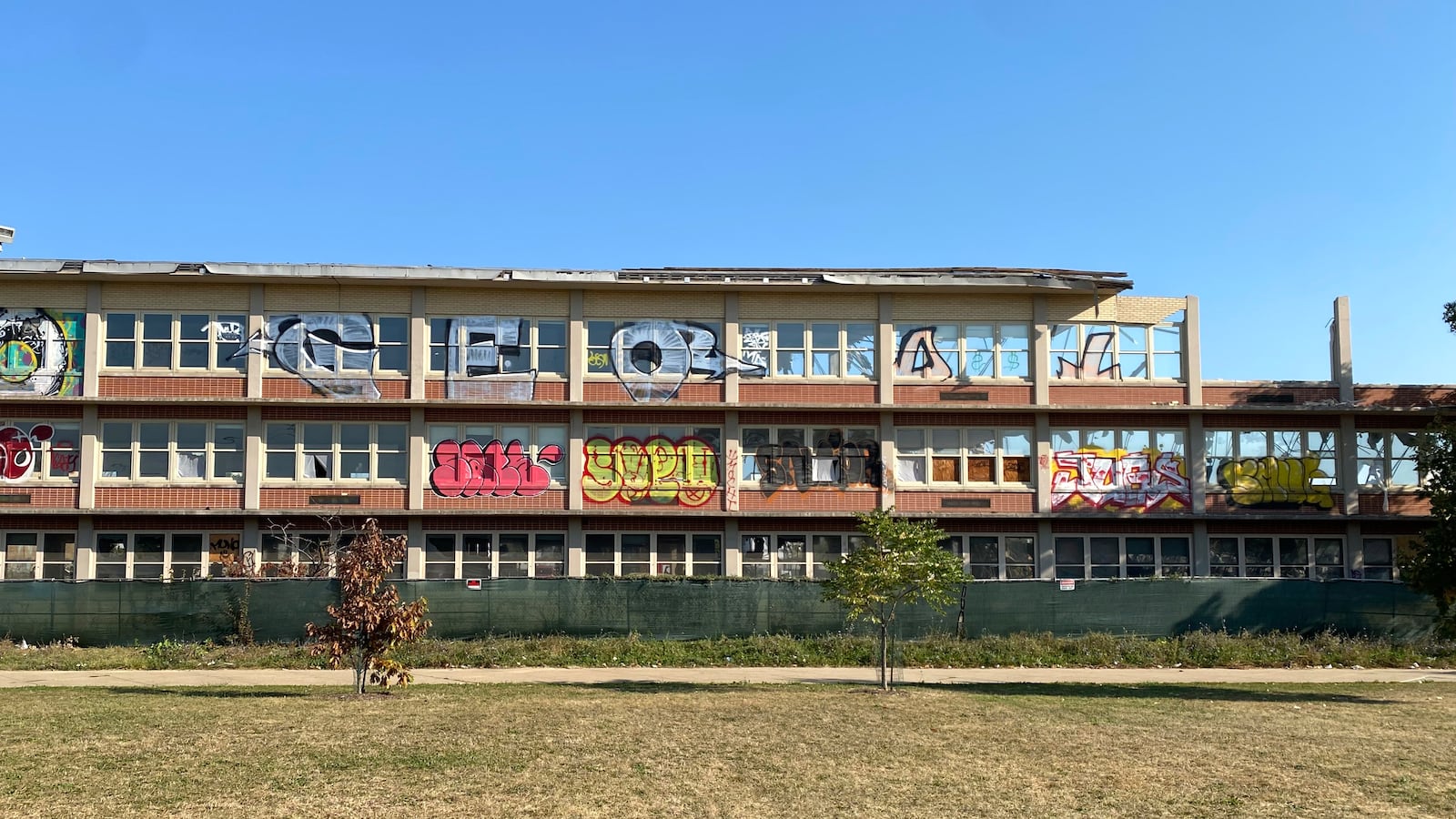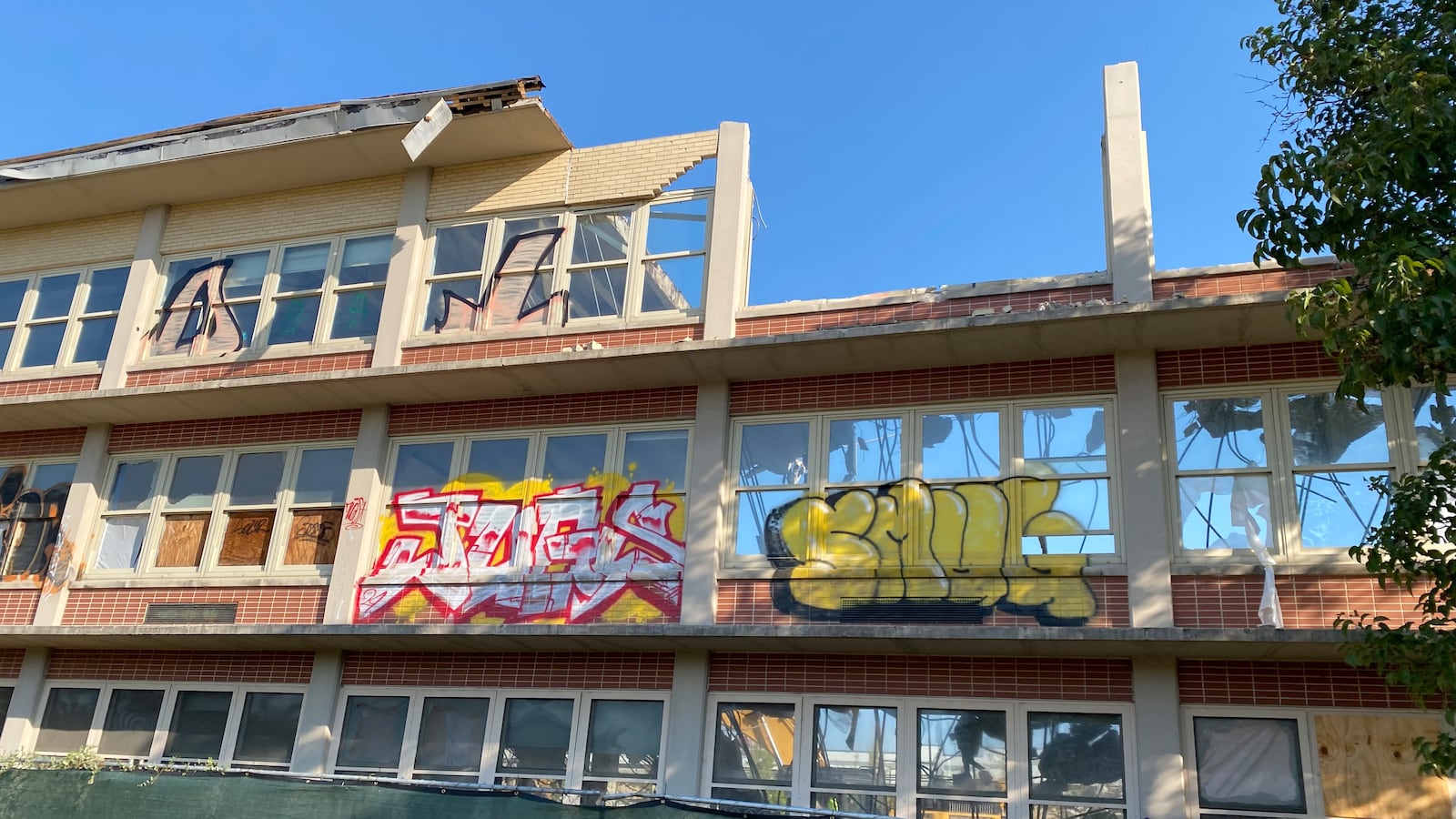Sign up for Chalkbeat Chicago’s free daily newsletter to keep up with the latest news on Chicago Public Schools.
The buildings have sat empty for 12 years.
Several are architecturally significant with striking details and character taking up multiple city blocks. But many are in rough shape, with copper stripped from the pipes, broken windows, and graffiti covering walls. One had to be torn down after an extra-alarm fire last year.
Now, Chicago Public Schools aims to sell the former schools, putting 20 properties out to bid once again, with the hopes of seeing them repurposed and the possibility of bringing in around $8.2 million and avoiding spending more on future upkeep.
“Our goal is not to sell them for the highest dollar amount, really. It’s to find the most responsible, compatible use,” said Stephen Stults, director of real estate for CPS. “What we get paid, of course, helps with our budget challenges. But they’ve been sitting there long enough, and we need to do everything we can to try to get them repurposed.”
The solicitation for bids, which are due May 30, includes mostly school buildings closed in 2013. Each property includes a minimum bid and all properties have schools on them with the exception of one on the Near West Side.
That property, the site of the old Dett Elementary, has a minimum bid of $1.3 million and sits about five blocks from the United Center in an area poised for a $7 billion development plan, called the 1901 Project, a nod to the sports stadium’s address.
The city demolished the school building last fall after a fire broke out in late May. Prior to the fire, CPS put the building on the market and received just one bid for $1, which was “below what the district was willing to accept.” Demolition cost the district $1.25 million.
All of the properties have deed restrictions that do not allow them to be used as a K-12 charter or school or for the sale of liquor or tobacco products.
Stults said CPS spends between $100,000 and $150,000 to maintain and secure each vacant school per year. That’s at least $2 million annually for the past 12 years — or $24 million. The ongoing expense comes as CPS is currently considering hundreds of layoffs in order to close a $529 million deficit for the coming school year.
Even though many vacant schools are not in great condition, Stults said the “bones of the buildings” are good. Demolition may be expensive, but so is rebuilding a core structure. After the deadline, he said the district will consider all bids and select the two “highest and most responsible” to present to the school board, as required by state law. Stults anticipates bringing some building sales to the board before the end of the calendar year.
If there is no demand for certain vacant schools, he added, the district plans to reach out to sister agencies, such as the Chicago Park District, to see if they’re interested in the properties.
Vacant schools are a visible reminder of the 2013 closures, which disproportionally impacted Black children from low-income families and led to further population loss. Many community groups and neighbors near these properties have called for reinvestment in these public assets for many years.
Efforts to sell and repurpose old CPS schools a mixed bag
Following the mass school closings in 2013, then-mayor Rahm Emanuel and CPS CEO Barbara Byrd-Bennet appointed a committee to develop guidelines for school repurposing and community development. Their early 2014 report laid out potential uses for each vacant school and recommended a process for repurposing.
CPS put 47 buildings up for sale and sold two dozen properties in subsequent years for a collective $38 million. Some have been redeveloped into luxury housing or private schools. One was torn down to make way for 30 new single-family homes and another was rehabbed into a union hall.
More recently, the former Emmet Elementary in Austin opened as a gleaming workforce training facility after a more than $40 million renovation supported by city, state, and philanthropic money. The former Overton Elementary in Grand Boulevard on the south side slowly transformed into a community hub with weekend market events and a community garden.
Ghian Foreman, a managing partner with the Washington Park Development Group, which has owned the building since 2015, said they will begin renovations to convert the building into offices later this year as soon as the city grants the permits.
“It’s harder than you think it is,” Foreman said. “This has been a really long process of learning. You have to really be committed, and you have to ensure that you have the resources to see it all the way through.”
Many vacant schools shuttered a decade ago have garnered interest from buyers and community proposals. But actual redevelopment has stalled for myriad reasons.
Some schools up for sale now had buyers previously, but the sales never went through. For example, the school board approved a bid for the old Henson Elementary in 2018, but the local aldermen at the time held it in a City Council committee. The building remains vacant. The school board in 2018 approved a bid for the old Morgan Elementary in Chatham from the Amalgamated Transit Union Local 241. But the project never came to fruition.
Some schools have been sold and are off the district’s books, but remain vacant and undeveloped.
One notable example is the old Von Humboldt school, which still sits vacant after being sold by the school board in 2015 for $3.1 million to the nonprofit IFF. The group planned to convert the old school in gentrifying Humboldt Park to a mixed-use building with affordable apartments and market-rate townhomes built on part of the parking lot. But IFF eventually sold the property to Newark, New Jersey-based RBH Group, which promised to convert it to a “Teachers Village” with subsidized housing for teachers, similar to projects it’s done in Atlanta, Newark, New Jersey, and Hartford, Connecticut.
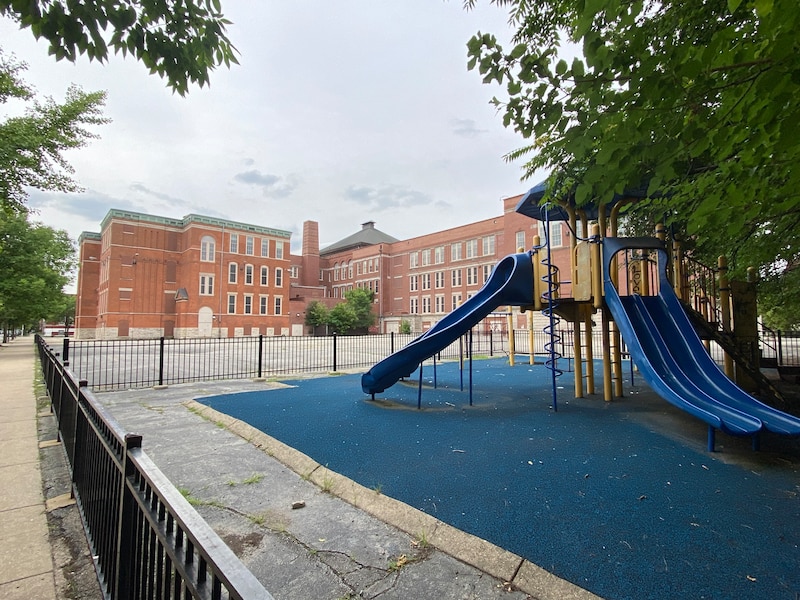
Ald. Daniel La Spata, 1st Ward, put brakes on the project in 2019, but it eventually got approval from the City Council in 2020. The city approved $18 million in tax-exempt bonds in 2022 and last fall, the Chicago Housing Authority committed 61 vouchers worth $20 million over 20 years. Today, the historic school built in 1884 sits waiting for activity.
Local elected officials influence vacant school sales
What to do with school real estate is another area of governmental entanglement between the city and the Chicago Board of Education.
By state law, the City of Chicago or the Public Building Commission hold the title “in trust for the use of schools.” The sale of old schools must be approved by the City Council in order for the deed to be transferred to a new owner. It also must be approved by two-thirds of the Chicago Board of Education, which now means 14 members must vote yes.
In the bid materials, interested buyers are encouraged to contact the local aldermen and local school board representatives for the properties they’re interested in purchasing.
Ald. Jeanette Taylor, who represents the 20th Ward on the south side, plans to hold meetings later this month to get feedback on repurposing the schools in her ward. Taylor is the City Council’s chair of the Committee on Education and Child Development and also participated in a hunger strike to keep Dyett High School open roughly a decade ago.
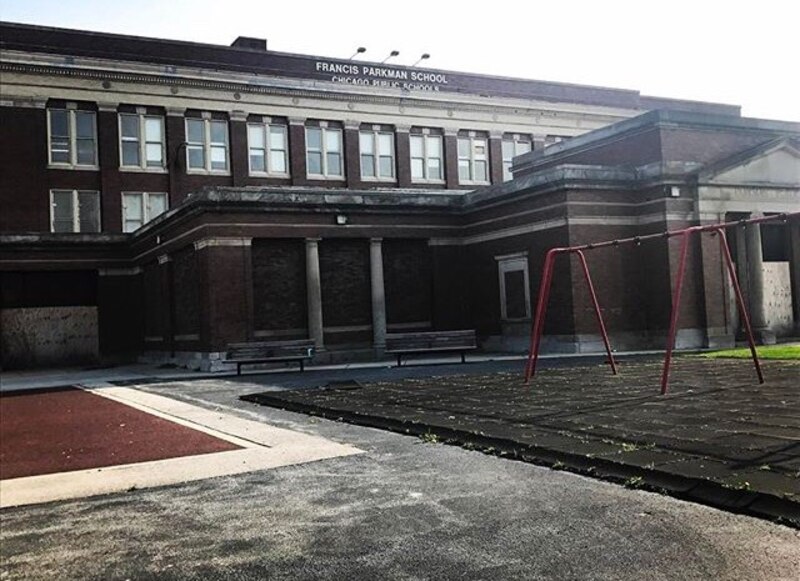
School board member Che “Rhymefest” Smith, who was elected to represent District 10 on the south side, said he hasn’t heard from any prospective buyers yet. He doesn’t want to prescribe any uses for the vacant buildings in his district but just hopes that investors would tune in to what communities in these neighborhoods want and need. He also thinks any money the district makes from the sales should be poured into schools in those neighborhoods.
“I would like to see any revenue benefit local schools rather than disappearing into the district bureaucracy,” he said.
When asked if she’d been contacted by anybody hoping to buy vacant schools, Therese Boyle, the elected school board representative for District 9 on the south side, said: “Not a soul.”
But she said what to do with these vacant properties is a critically important question for communities, especially given the district’s looming deficit.
“We need every penny for the operation of the schools that are open,” Boyle said.
Boyle, a retired school psychologist, worked inside the old Wentworth school building now up for sale when it was closed in 2013. She remembered how difficult it was for students and staff to move to a new building and said it’s awful to have an old school sitting empty in a neighborhood.
Michilla Blaise, who was appointed to the school board by Mayor Brandon Johnson to represent District 5 on the west side, said she’s been talking with district, city, and county officials about what to do with the old vacant schools. She said it’s important to do something because right now, they’re just reminders of neighborhood disinvestment for the people who live around them.
Foreman, the community developer that owns the old Overton school, echoed that sentiment. For the 10 years he’s owned the old school, he’s allowed the community to use the gym to play basketball and workout. He had to stop that in the past year to prepare for construction and said there have been break-ins recently, but not from people looking to steal things.
“They were young people who wanted to come and play in the gym,” he said.
Even though financing Overton’s redevelopment has been a big challenge, Foreman questioned the argument often made by city officials that it’s too costly to repurpose these properties or make them available to the community while trying to sell them or even demolish them for use as a park.
“What’s more expensive?” he asked. “What we pay the police in overtime or opening up a gym for the kids to play basketball?”
Mila Koumpilova contributed reporting.
Becky Vevea is the bureau chief for Chalkbeat Chicago. Contact Becky at bvevea@chalkbeat.org.

